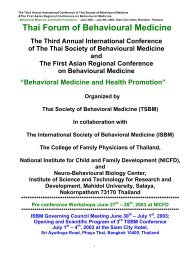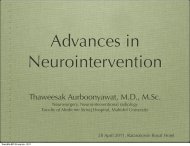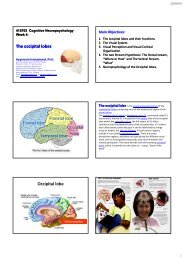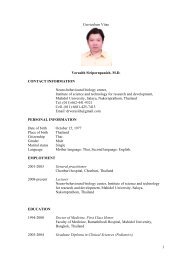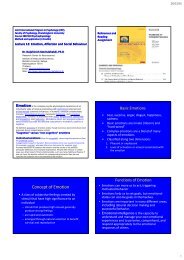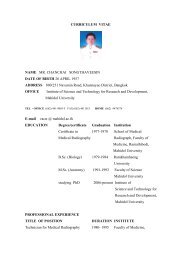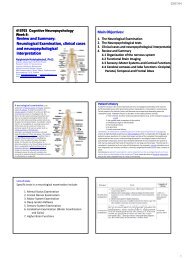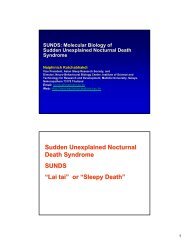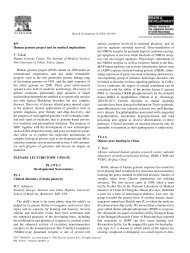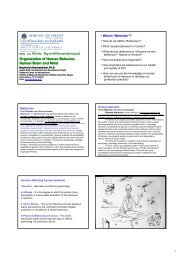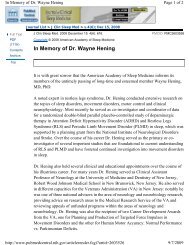The Frontal lobes - Mahidol University
The Frontal lobes - Mahidol University
The Frontal lobes - Mahidol University
Create successful ePaper yourself
Turn your PDF publications into a flip-book with our unique Google optimized e-Paper software.
19/07/54<br />
Brodmann area 10, or BA10<br />
is the<br />
frontopolar part of the frontal cortex in the human brain.<br />
BA10 was originally defined in terms of microscopic<br />
cytoarchitecturic traits in autopsy brains; modern functional<br />
imaging research cannot directly identify these boundaries<br />
and the terms anterior prefrontal, rostral prefrontal cortex<br />
and frontopolar prefrontal cortex are used to refer to the<br />
area in the most anterior part of the frontal cortex that<br />
approximates to or principally covers BA10.<br />
BA10 is the largest cytoarchitectonic area in the human<br />
brain. It has been described as "one of the least well<br />
understood dregions of the human brain". Present research<br />
suggests that it is involved in strategic processes in memory<br />
retrieval and executive function. During human evolution,<br />
the functions in this area resulted in its expansion relative to<br />
the rest of the brain.<br />
Although this region is extensive in humans, its function is poorly understood.<br />
Koechlin & Hyafil have proposed that processing of 'cognitive branching' is the<br />
core function of the frontopolar cortex. Cognitive branching enables a<br />
previously running task to be maintained in a pending state for subsequent<br />
retrieval and execution upon completion of the ongoing one. Many of our<br />
complex behaviors and mental activities require simultaneous engagement of<br />
multiple tasks, and they suggest the anterior prefrontal cortex may perform a<br />
domain‐general function in these scheduling operations. However, other<br />
hypotheses have also been proffered, such as those by Burgess et al.<br />
Brain: Brodmann area 10<br />
Brodmann area 11 is one of Brodmann's<br />
cytologically defined regions of the brain. It is<br />
involved in planning, reasoning, and decision<br />
making.<br />
Brodmann area 11, or BA11, is part of the frontal cortex in the<br />
human brain. BA11 covers the medial part of the ventral surface of<br />
the frontal lobe.<br />
Prefrontal area 11 of Brodmann‐1909 is a subdivision of the frontal<br />
lobe in the human defined on the basis of cytoarchitecture. Defined<br />
and illustrated in Brodmann‐1909, it included the areas<br />
subsequently illustrated in Brodmann‐10 as prefrontal area 11 and<br />
rostral area 12.<br />
prefrontal area 11 is a subdivision of the cytoarchitecturally defined<br />
frontal region of cerebral cortex of the human. As illustrated in<br />
Brodmann‐10, It constitutes most of the orbital gyri, gyrus rectus<br />
and the most rostral portion of the superior frontal gyrus. It is<br />
bounded medially by the inferior rostral sulcus (H) and laterally<br />
approximately by the frontomarginal sulcus (H). Cytoarchitecturally<br />
it is bounded on the rostral and lateral aspects of the hemisphere<br />
by the frontopolar area 10, the orbital area 47, and the triangular<br />
area 45; on the medial surface it is bounded dorsally by the rostral<br />
area 12 and caudally by the subgenual area 25. In an earlier map,<br />
the area labeled 11, i.e., prefrontal area 11 of Brodmann‐1909, was<br />
larger; it included the area now designated rostral area 12.<br />
Brain: Brodmann area 11<br />
Brodmann area 46, or BA46<br />
46, is part of the frontal cortex<br />
in the human brain. It is between BA10 and BA45.<br />
BA46 is known as middle frontal area 46. In the human brain it<br />
occupies approximately the middle third of the middle frontal<br />
gyrus and the most rostral portion of the inferior frontal gyrus.<br />
Brodmann area 46 roughly corresponds with the dorsolateral<br />
prefrontal cortex (DLPFC), although the borders of area 46 are<br />
based on cytoarchitecture rather than function. <strong>The</strong> DLPFC also<br />
encompasses part of granular frontal area 9, directly adjacent on<br />
the dorsal surface of the cortex.<br />
Cytoarchitecturally, BA46 is bounded dorsally by the granular frontal area<br />
9, rostroventrally by the frontopolar area 10 and caudally by the<br />
triangular area 45 (Brodmann‐1909). <strong>The</strong>re is some discrepancy between<br />
the extent of BA8 (Brodmann‐1905) and the same area as described by<br />
Walker (1940)<br />
<strong>The</strong> DLPFC plays a role in sustaining attention and working<br />
memory. Lesions to the DLPFC impair short‐term memory and<br />
cause difficulty inhibiting responses. Lesions may also eliminate<br />
much of the ability to make judgements about what's relevant<br />
and what's not as well as causing problems in organization.<br />
<strong>The</strong> DLPFC has recently been found to be involved in exhibiting<br />
self‐control. <strong>The</strong> dorsolateral prefrontal cortex, which is one of the few<br />
areas deactivated during REM sleep. Neuroscientist J. Allan Hobson has<br />
hypothesized that activation of the dorsolateral prefrontal cortex produce<br />
lucid dreams.<br />
Brain: Brodmann area 46<br />
<strong>The</strong> limbic system is also tightly connected to the<br />
prefrontal cortex.<br />
Some scientists contend that this connection is<br />
related to the pleasure obtained from solving problems. To<br />
cure severe emotional disorders, this connection was<br />
sometimes surgically severed, a procedure of<br />
psychosurgery, called a prefrontal lobotomy. Patients who<br />
underwent this procedure often became passive and<br />
lacked all motivation.<br />
<strong>The</strong>re is circumstantial evidence that the limbic<br />
system also provides a custodial function for the<br />
maintenance of a healthy conscious state of mind.<br />
28



